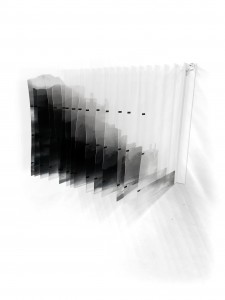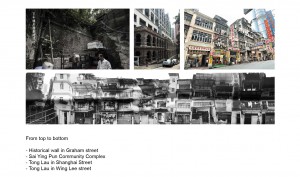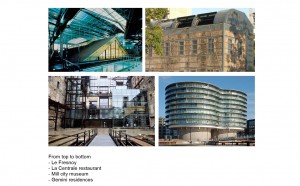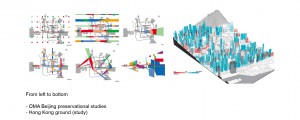[EN]ROOT
|
In response to the sectional mapping of Hong Kong, a better approach to preservation and alternative planning would be developed to achieve a permanent interface shared by the old and new constructions in the city. What The thesis would target sites that have significance historic values and memories attached to the local – especially ordinary buildings for ordinary people (Tong Lau). Apparently the issues on buildings safety and structure are always considered to be the main reason to undergo demolition of the whole heritage building. In this thesis, previous interventions will be studied and experimented to allow any better approach to the heritage buildings in Hong Kong in order to deal with the urban planning needs. Apparently the urban planning of Hong Kong has always been focused on plans, the sections of the entire city should also be taken into consideration. Since Hong Kong has a compelling topography, it will be interesting to explore any opportunities in developing the idea of heritage conservation in relation to urban development. Sectional mapping of Hong Kong will be studied in this thesis to develop the potential idea of sectional preservation. The site for the thesis has not been finalised but possible site examples could be Wing Lee Street (Hong Kong island) or the Tong Laus along Shanghai Street (Mong Kok), since both sites are contested areas on many dimensions and they comprise of rich context and stories. In addition, both sites are situated in a high-value land plot, which means there are many opportunities for new building construction to take place within these vibrant areas for the developers to earn profit. Sooner or later, the Tong Laus will be demolished completely according to the common practice in Hong Kong Urban Renewal Authority and subsequently replaced with skyscrapers. Layers and layers of history and the richness will gradually be lost within this city. The thesis would start from looking at all existing Tong Laus in Hong Kong in relation to their existing territories and conditions, then narrow down to a single or multiple block scale. Through studying the global precedents of preservation, possible solutions and strategies would be reached in dealing with the preservation and conservation issues. Why The idea of preservation or restoration of ancient monuments have been raised since after the French revolution. The scale of what and how to preserve have become more ambitious. Historical models like Palazzo della Ragione and the Castelvecchio project have introduced the ways of blending the old and new construction through addition or extension. Not based on imitation, but by understanding the deep roots of the history, culture and architectural meanings, the architects provided architectural response and design approaches to the interventions. Historical preservation and new development within the field of architecture has always been a controversial topic. Nowadays many architects have also been establishing new relationships of the new work to the existing building to prove that through transformation, the existing building and new functions/programs can co-exist. Preservation methods like ‘Insertions’ for La Centrale restaurant, ‘Parasites’ for Gemini residences, ‘Wraps’ on Le Fresnoy national studio for contemporary art, ‘Juxtapositions’ on Higgins Hall and ‘Weaving’ on Mill city museum etc are a few of the examples. In terms of city scale, OMA has worked on the Beijing Preservation which they analysed the entire plan of Beijing to produce a planning discipline. Rem Koolhaas proposed a most visionary approach to preservation in a prospective rather than retrospective way by declaring different areas of the city to be preserved for different periods of time. There seems to be a contradiction between conserving heritage and urban development in Hong Kong. Has the heritage ever important that contributes to the richness of a city? Does the heritage building have to be fully demolished to allow new buildings to exist to fulfill the needs in the current society? Are there another ways of interventions/conservation for the heritage buildings? With the aid of the local conditions or territories (i.e. Hong Kong’s topography-slopes and hills), could the new ‘merge’ with the old construction without affecting the latter structurally? Through examining the precedents of previous interventions in macro and micro scale, this thesis would propose possible strategies and proposals to blend in the urban development with the conservation projects in Hong Kong. How The Tong Laus that are built in 50s or before will be mapped out with a sectional mapping across Hong Kong for analysis. Based on exploring the precedents of previous preservation/intervention locally and globally, and exploring Hong Kong’s topography, better approach and ideas to preservation in Tong Laus will commence. The schedule of the thesis would be as follows: Step 01 Map out the 50s or before Tong Laus in Hong Kong and study their existing territories and conditions. (due Dec 17) Step 02 Sectional mapping of Hong Kong’s topography will be carried out to explore the opportunities in conservation. Potential heritage sites would be studied and chosen due to its significance and influence in Hong Kong. Urban strategies would be taken into consideration. (due Review 1.0) Step 03 Precedents and preservational methods will be examined and studied the possibilities in applying them to Hong Kong situations. The material and structure of existing heritage buildings would also be examined for any possibilities to incorporate with the new building development – with the aid of Hong Kong’s topography (e.g. retain wall systems). Physical models will be produced for testing. (due Review 2.0) Step 04 Revisions and refinements will be carried out. Methodologies or design ideas will commence based on the exploration of intrinsic and extrinsic relationships between the existing and the new architecture. (due Review 3.0) Bibliography |



